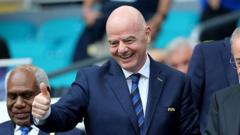Is the Club World Cup Really the Most Successful Club Competition?

The FIFA Club World Cup: A Controversial Yet Profitable Competition
The FIFA Club World Cup has stirred considerable debate within the football community, especially following comments made by FIFA President Gianni Infantino at Trump Tower in New York. Infantino asserts that the tournament has already established itself as "the most successful club competition in the world." His statements come in light of both immense revenue generation and significant criticism surrounding player welfare and match attendance. This article delves into the various aspects of the FIFA Club World Cup, examining its financial successes, the criticisms it has faced, and the implications for the future of global club football.
The Financial Success of the Club World Cup
Infantino's claims of financial success are supported by impressive revenue statistics. He noted that the competition has generated over $2 billion, averaging $33 million per match. This figure positions the Club World Cup as a financial powerhouse compared to other tournaments. Let's break down the financial aspects:
- Revenue Generation: With over $2 billion in revenue, the tournament has proven to be a lucrative venture for FIFA.
- Average Earnings: The reported average earnings of $33 million per match highlight the financial viability of the competition.
- Attendance Figures: Infantino reported over 2.5 million spectators, averaging around 40,000 fans per match, which is comparable to or exceeds many league matches globally.
This level of financial success suggests a thriving market for club football on a global scale, which Infantino believes marks the beginning of a "golden era" for the sport.
Mixed Reactions from the Football Community
Despite the financial triumph, the Club World Cup has faced substantial backlash from various quarters. Notably, former Liverpool manager Jurgen Klopp described the tournament as "the worst idea ever implemented in football." This criticism highlights the divide between FIFA's perspective and that of players, coaches, and fans. Here are some key points of contention:
Attendance Issues
Many matches during the tournament have seen poor attendance, with reports indicating over a million empty seats. This raises questions about the overall interest in the competition and its scheduling:
- Empty Seats: The noticeable lack of fans in stadiums can detract from the event's atmosphere and prestige.
- Summer Scheduling: The decision to move the tournament to summer has been controversial, with concerns over heat and player fatigue becoming central topics of discussion.
Player Welfare Concerns
Several players, including Jude Bellingham and Reece James, have spoken out about the challenging conditions, particularly the extreme heat. Chelsea midfielder Enzo Fernandez went as far as to describe the weather as "very dangerous." Such conditions have raised alarms about player safety and performance:
- High Temperatures: With temperatures reaching up to 38°C (100°F), concerns about heat exhaustion and the quality of play have emerged.
- Pitch Quality: Players have criticized the quality of the pitches, which can affect gameplay and increase the risk of injury.
FIFA's Response to Criticism
Addressing the concerns raised by players and coaches, Infantino acknowledged that the high summer temperatures are "definitely an issue." He emphasized the need for FIFA to prioritize player welfare, particularly with the upcoming 2026 World Cup set to take place in the United States, Canada, and Mexico. Here’s what FIFA plans to do:
- Cooling Breaks: FIFA is considering implementing cooling breaks during matches to help manage extreme temperatures.
- Stadium Selection: Infantino mentioned that they would utilize covered stadiums more effectively, such as the Mercedes-Benz Stadium in Atlanta and others in Vancouver, Dallas, Houston, and Los Angeles.
Infantino's willingness to adapt the tournament in response to feedback reflects a recognition of the importance of player health and safety in professional sports.
The Future of the Club World Cup
As the Club World Cup evolves, its future hinges on several factors, including scheduling, player welfare, and global fan engagement. The upcoming 2026 World Cup will serve as a crucial test for FIFA’s ability to manage large-scale events under challenging conditions. Here are some considerations for the future:
Adapting to Global Trends
The landscape of football is constantly shifting, with increased commercialization and fan expectations. FIFA must adapt to these changes to maintain the relevance and appeal of the Club World Cup:
- Incorporating Fan Feedback: Listening to fans and stakeholders will be vital for FIFA to ensure the tournament meets expectations.
- Innovative Scheduling: Finding optimal dates and times that align with both fan attendance and player welfare will be critical.
Enhancing Global Engagement
To solidify the Club World Cup's status as a premier football event, FIFA should focus on enhancing global engagement:
- Promoting Diversity: Ensuring that clubs from various regions are represented can increase global interest and participation.
- Leveraging Technology: Utilizing innovative broadcasting and fan engagement technologies can make the tournament more accessible to global audiences.
Conclusion: A Balancing Act for FIFA
The FIFA Club World Cup stands at a crossroads. While its financial success is undeniable, the criticisms it faces cannot be ignored. FIFA President Gianni Infantino's optimistic view of the tournament as a "huge success" must be tempered with an understanding of player welfare and fan engagement. As the tournament progresses, FIFA’s ability to adapt and respond to criticism will determine its future viability. Will the Club World Cup evolve into the premier global club competition that Infantino envisions, or will it struggle to gain the acceptance of the footballing community?
FAQs
What is the FIFA Club World Cup?
The FIFA Club World Cup is an international club football tournament featuring the champion clubs from each of the six continental confederations, along with the champion club from the host nation.
How does the Club World Cup generate revenue?
The tournament generates revenue through ticket sales, broadcasting rights, sponsorship deals, and merchandise sales.
What are the main criticisms of the FIFA Club World Cup?
The main criticisms include poor attendance, player welfare concerns due to extreme weather conditions, and the overall scheduling of the tournament.
How does FIFA plan to address player welfare issues?
FIFA plans to implement cooling breaks during matches and utilize covered stadiums to mitigate the effects of extreme heat on players.
As the FIFA Club World Cup continues to develop, balancing financial success with the welfare of players and the engagement of fans will be critical. Will FIFA rise to the challenge? #FIFACup #Football #PlayerWelfare
Published: 2025-07-12 18:01:10 | Category: sport



